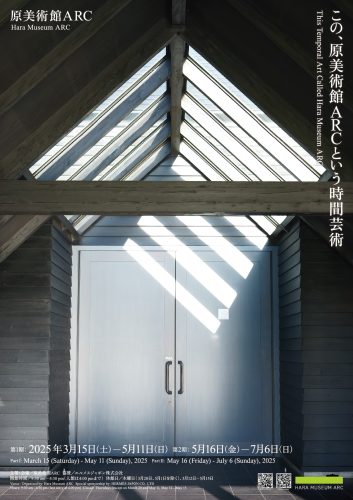
Is Hara Museum ARC not a work of temporal art?
In spring, flower petals dance and birds chirp. In early summer, plants sprout, rainbows arc across the eastern sky after a sudden shower and rays of sunlight burst through cloud breaks in the west. The museum designed by Arata Isozaki spreads its wings against a backdrop of ever-changing nature. In the galleries, one encounters richly individualistic artworks under natural light from skylights above. In the corridor, one catches sight of sheep grazing silently in the distance. Standing among the blooming white clover in the garden, outdoor artworks like Aiko Miyawaki’s UTSUROHI and Minami Tada’s Chiaroscuro No. 2 blend harmoniously with the environment. Is this museum called Hara Museum ARC, with each of its elements connecting at its own gentle pace with the time you spend here, not like a work of poetry or music? In other words, a work of temporal art?
In the spring of 2025, Hara Museum ARC will hold an exhibition entitled This Temporal Art Called Hara Museum ARC. In Part I, for a limited time only, a sound installation by Janet Cardiff, The 40 Part Motet, will be on display in Gallery A. This resurrection of a 40-part composition by Thomas Tallis (a 16th-century English composer and organist for the Royal Chapel) is an early representative work by Cardiff that has been shown throughout the world since its inception in 2001.
From 40 speakers arranged in an oval, 40 recorded voices can be heard, first individually, but then gradually merged, transforming the venue into an immersive space with all voices coming together in the moment. In terms of lyrics, there are only a few lines, but the experience of space sculpted by sound is an overwhelming reminder of the ineffable nature of art.
Gallery A at Hara Museum ARC, designed by Arata Isozaki, is illuminated by natural light from a 12-meter-high skylight supported by four cedar pillars, its intensity modulated by the passing clouds. Although the gallery has all the characteristics of a white cube for contemporary art, it is a space with the breath of nature, designed as an expression of “ma,” the spatial and temporal concept believed by Isozaki to be the essence of Japanese aesthetics. It serves as a unique venue for Cardiff’s sound installation The Forty Part Motet.
*Temporal arts refer to arts that are expressed or enjoyed over time, the main examples of which are music and literature.
Meanwhile, Galleries B and C will feature Exquisite Pain by Sophie Calle from the museum’s collection. It is an account through images and text of Calle’s countdown to “the worst day of her life” and the recovery she achieved through the exchange of her story of pain with those of others.
In Part II from May 16, Gallery A will feature works from the Hara Collection with a thematic connection to the passage of time, including Lee Ufan’s With Winds which appeared in his solo exhibition at the museum and works from Tadasu Yamamoto’s Falling Water series.
We hope you will enjoy the temporal art that is Hara Museum ARC where sights that can only be enjoyed here await you.
Special Exhibit: Janet Cardiff, The Forty Part Motet (A reworking of “Spem in Alium” by Thomas Tallis 1573)
Venue: Gallery A
Dates: Saturday, March 15 – Sunday, May 11, 2025
The Forty Part Motet is a reworking of Spem in Alium (1573) by Thomas Tallis (b. circa 1505/d. 1585), an English composer for the royal court and organist for the Chapel Royal. Forty separately recorded voices are played back through forty speakers placed in an oval in the space. The speakers are configured in eight separate choirs each consisting of five voices (soprano, alto, tenor, baritone and bass).
Quote from Janet Cardiff
“While listening to a concert you are normally seated in front of the choir, in traditional audience position. With this piece I want the audience to be able to experience a piece of music from the viewpoint of the singers. Every performer hears a unique mix of the piece of music. Enabling the audience to move throughout the space allows them to be intimately connected with the voices. It also reveals the piece of music as a changing construct. As well I am interested in how sound may physically construct a space in a sculptural way and how a viewer may choose a path through this physical yet virtual space.
I placed the speakers around the room in an oval so that the listener would be able to really feel the sculptural construction of the piece by Tallis. You can hear the sound move from one choir to another, jumping back and forth, echoing each other and then experience the overwhelming feeling as the sound waves hit you when all of the singers are singing.”
Artist Profile
Janet Cardiff (1957-) is a Canadian artist based in British Columbia, a province of Canada rich in nature. In 1999, she exhibited at the Carnegie International in Pittsburgh, and in 2001, won the Special Award at the 49th Venice Biennale together with her collaborator George Bures Miller as the Canadian representatives. In Japan, they participated in the Yokohama Triennale (2005) and Aichi Triennale (2013) and held solo exhibitions at Maison Hermes Forum in Ginza and the 21st Century Museum of Contemporary Art in Kanazawa. Their installation Storm House enjoyed great popularity at at Benesse Art Site Naoshima (2010-2021).
Scheduled Works from the Hara Museum Collection
Gallery A (May 16 – September 7): Lee Ufan, With Winds / Tadasu Yamamoto, Falling Water and others
Gallery B & C: Sophie Calle, Exquisite Pain and others
Kankai Pavilion: Aiko Miyawaki, UTSUROHI / Shigeo Toya, Spirit Regions and others
Semi-permanent installations: Yayoi Kusama, Mirror Room (Pumpkin) / Tabaimo, Midnight Sea / Yoshitomo Nara, My Drawing Room and others
Outdoor installations: Andy Warhol, Campbell’s Tomato Soup / Olafur Eliasson, Sunspace for Shibukawa / Jean-Michel Othoniel, Kokoro / Yasuhiro Suzuki, Bench of the Japanese Archipelago and others
Sophie Calle, Exquisite Pain, 1999
Venue: Gallery B & C
Dates: Saturday, March 15 – Sunday, May 11 / Friday, May 16 – Sunday July 6, 2025
“The three months in Japan were a countdown to the worst day of my life.”
The work Exquisite Pain, which was born as a result of the artist’s stay in Japan and was exhibited in 1999 at the Hara Museum of Contemporary Art in Tokyo (closed in 2021) in line with the artist’s wish to launch it first in Japan. The initial version was thus in Japanese, followed by French and English versions for later exhibits around the world.
“Exquisite pain” is a medical term for a sharp, localized pain that is used by Calle to describe a broken relationship that she experienced. In the first part of this two-part work, the story of her pain and recovery is told through photographs and texts. Letters to her most beloved person and photographs of the days up until the fateful day of the breakup. Part II follows the gradual recovery that she achieved by sharing her story with others and hearing theirs in return. The unfolding of this story and her encounters with others clearly touched the hearts of many viewers. Through it all, however, runs a fuzzy distinction between fact and fiction which underscores the danger of unquestioning belief.
